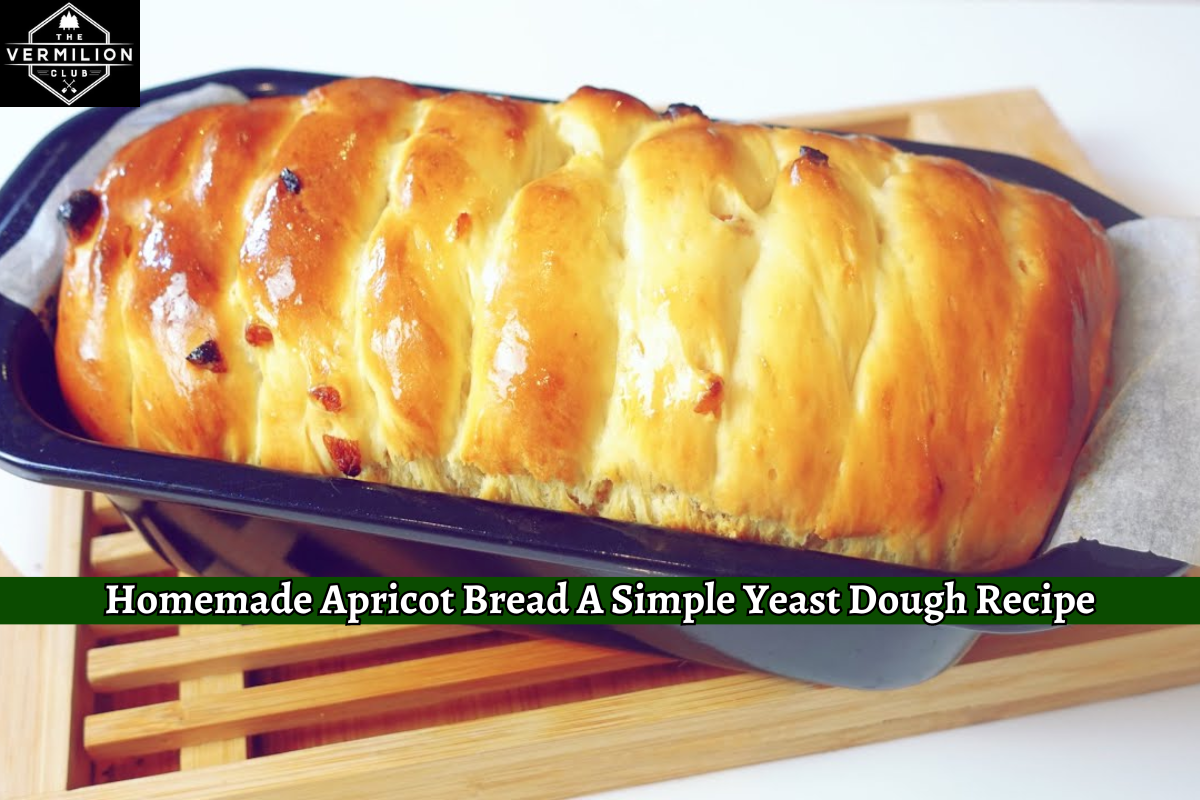Homemade Apricot Bread A Simple Yeast Dough Recipe: There is a sense of profound fulfilment that comes from baking your own bread, particularly when it is infused with the sweet and tangy flavour of apricots.
Homemade Apricot Bread A Simple Yeast Dough Recipe
I will walk you through the steps of making homemade apricot bread from scratch using this recipe that I have provided for you. This bread is ideal for breakfast, brunch, or as a delightful snack at any time of the day because it is made with a straightforward yeast dough and the natural sweetness of dried apricots.
Ingredients
- 2 cups all-purpose flour
- 1 packet (2 1/4 teaspoons) active dry yeast
- 1/4 cup warm water (around 110°F)
- 1/4 cup granulated sugar
- 1/2 teaspoon salt
- 1/2 cup milk
- 2 tablespoons unsalted butter
- 1/2 cup chopped dried apricots
- 1 egg, beaten (for egg wash)
- Optional: sliced almonds for topping
Also See:
Brown Butter Pumpkin Bread Recipe
Instructions
- To activate the yeast, dissolve the yeast and a pinch of sugar in warm water in a small bowl.
- This will activate the yeast. Wait for it to sit for approximately five to ten minutes until it becomes foamy.
- Getting ready to make the dough involves combining the flour, the remaining sugar, and the salt in a large mixing bowl.
- Heat the butter and milk together in a saucepan until the butter is completely melted. Before incorporating it into the flour mixture, allow it to cool down a little bit.
- Additionally, incorporate the mixture of activated yeast. Stir until a dough that is soft is formed.
- The dough should be kneaded by turning it out onto a surface that has been lightly dusted with flour and kneading it for approximately five to seven minutes, or until it becomes smooth and elastic.
- It is important to ensure that the chopped dried apricots are distributed evenly throughout the dough as you incorporate them into the dough during this process.
- For the first rise, place the dough that has been kneaded in a bowl that has been greased, cover it with a clean kitchen towel or plastic wrap, and allow it to rise in a warm place that is free from drafts for approximately one to one and a half hours, or until it has doubled in size.
- In order to shape the loaf, punch down the dough after it has risen to release any air bubbles that may have formed.
- Create a loaf out of it and place it in a loaf pan that has been greased as well. Cover it once more and allow it to rise for an additional thirty to forty minutes.
- While this is going on, preheat the oven to 350 degrees Fahrenheit (175 degrees Celsius).
- Egg wash and topping: Before baking, give the loaf a shiny finish by brushing it with beaten egg.
- This was done before the loaf was baked. In order to enhance the flavour and texture of the dish, you may choose to sprinkle some sliced almonds on top.
- Bake the loaf by placing it in an oven that has been preheated and baking it for twenty-five to thirty minutes, or until it reaches a golden brown colour and makes a hollow sound when tapped on the bottom.
- After it has been baked, take the bread out of the oven and allow it to cool for a few minutes in the pan before transferring it to a wire rack to cool completely. After that, slice the bread. Cut and savour the meal!
FAQ
Q1. Can I substitute rapid rise or instant yeast for the active dry yeast?
This recipe uses active dry yeast, but you can substitute rapid rise or instant yeast in it place. That’s up to you. If you want the dough to rise and double faster, you can use the same amount of active dry yeast (2 1/4 teaspoons) or less rapid rise yeast (1 3/4 teaspoons instead of 2 1/4 teaspoons).
If you use instant or rapid rise yeast, you can add it right to the dry ingredients, along with the flour. You don’t need to dissolve it first in the wet ingredients.
Q2. Can I knead the dough by hand instead of using a stand mixer?
Yes! You can knead the dough by hand, but keep in mind your dough might end up a little more dry than if used a stand mixer. In a large bowl, use a wooden spoon to mix the dough ingredients together until a shaggy dough forms and most of the dry ingredients are mixed in. Pour what’s in the bowl out onto a clean surface.
Using the heel of your hands, fold and press down on the dough, repeating this movement, while rotating the dough 90° with every press. As you knead the dough some more, dip your hands in flour every so often to keep it from sticking. At first, the dough will look sticky, so don’t add more flour to it. Instead, dust your hands with flour.
As you knead the dough, it should get firmer and smoother. But if you do need to add more flour, do it 1 tablespoon at a time. Before you stop kneading, the dough should be smooth and stretchy. This should take about 5 to 7 minutes.



